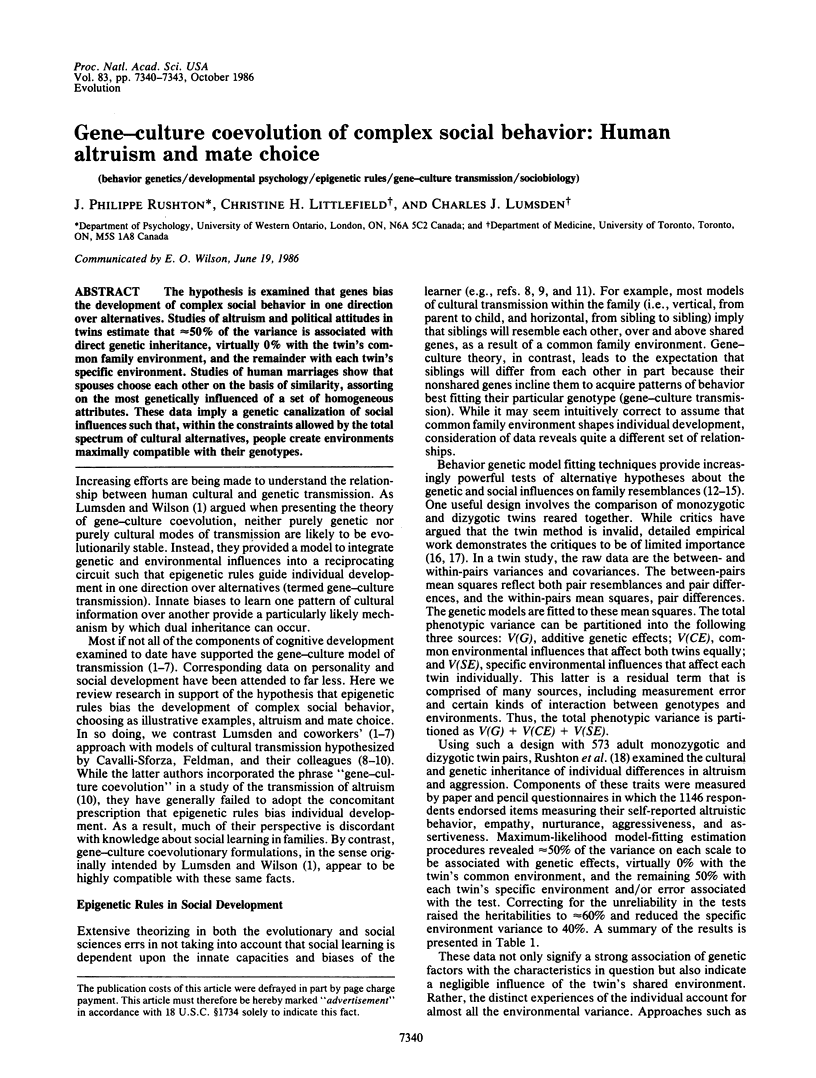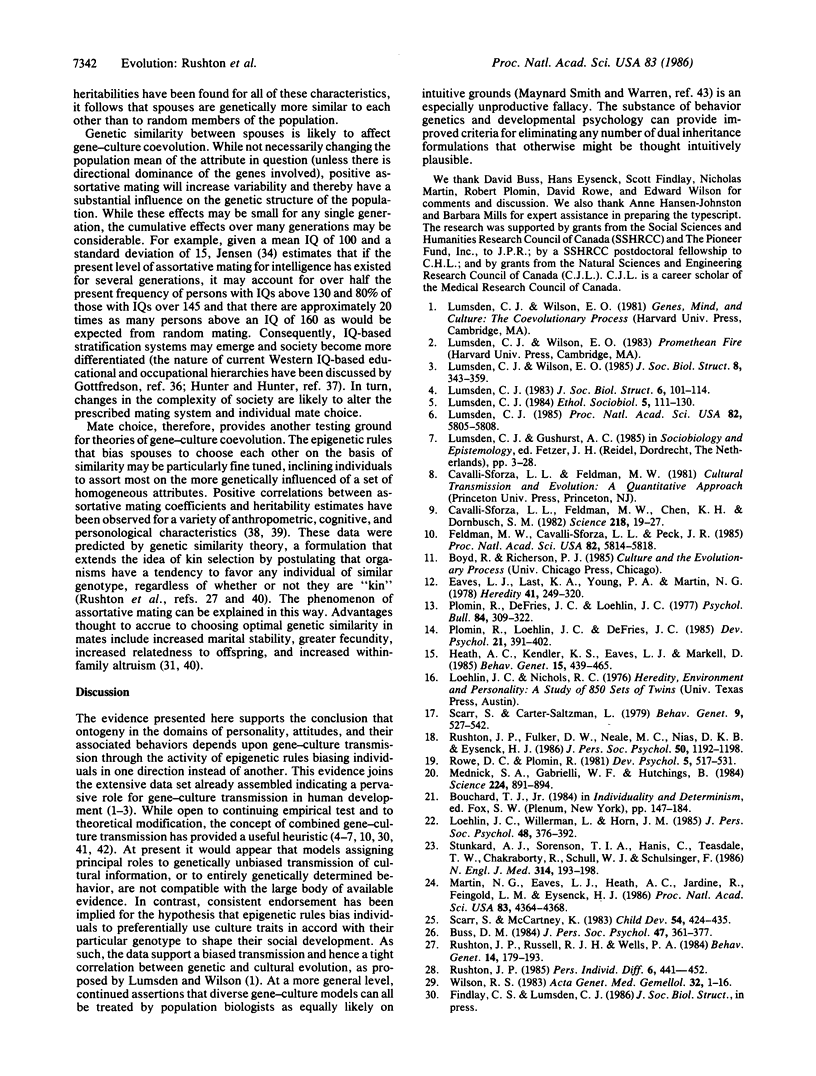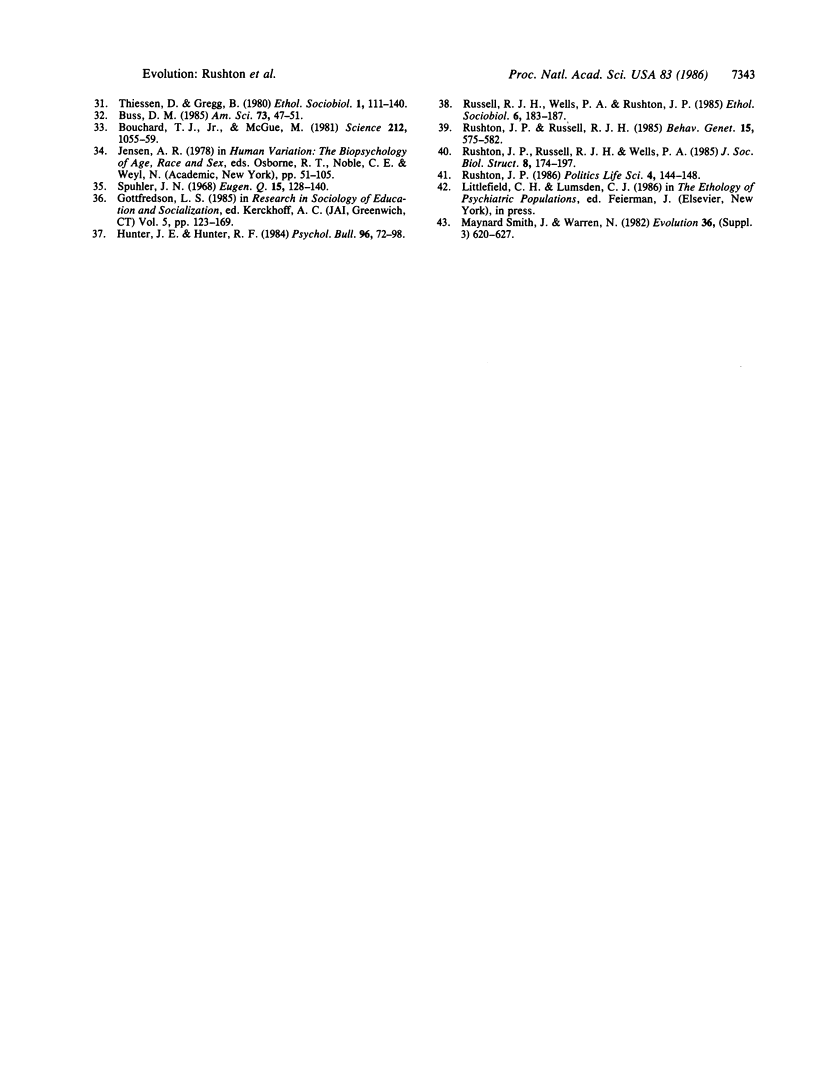Abstract
The hypothesis is examined that genes bias the development of complex social behavior in one direction over alternatives. Studies of altruism and political attitudes in twins estimate that approximately 50% of the variance is associated with direct genetic inheritance, virtually 0% with the twin's common family environment, and the remainder with each twin's specific environment. Studies of human marriages show that spouses choose each other on the basis of similarity, assorting on the most genetically influenced of a set of homogeneous attributes. These data imply a genetic canalization of social influences such that, within the constraints allowed by the total spectrum of cultural alternatives, people create environments maximally compatible with their genotypes.
Full text
PDF



Selected References
These references are in PubMed. This may not be the complete list of references from this article.
- Bouchard T. J., Jr, McGue M. Familial studies of intelligence: a review. Science. 1981 May 29;212(4498):1055–1059. doi: 10.1126/science.7195071. [DOI] [PubMed] [Google Scholar]
- Cavalli-Sforza L. L., Feldman M. W., Chen K. H., Dornbusch S. M. Theory and observation in cultural transmission. Science. 1982 Oct 1;218(4567):19–27. doi: 10.1126/science.7123211. [DOI] [PubMed] [Google Scholar]
- Eaves L. J., Last K. A., Young P. A., Martin N. G. Model-fitting approaches to the analysis of human behaviour. Heredity (Edinb) 1978 Dec;41(3):249–320. doi: 10.1038/hdy.1978.101. [DOI] [PubMed] [Google Scholar]
- Feldman M. W., Cavalli-Sforza L. L., Peck J. R. Gene-culture coevolution: models for the evolution of altruism with cultural transmission. Proc Natl Acad Sci U S A. 1985 Sep;82(17):5814–5818. doi: 10.1073/pnas.82.17.5814. [DOI] [PMC free article] [PubMed] [Google Scholar]
- Heath A. C., Kendler K. S., Eaves L. J., Markell D. The resolution of cultural and biological inheritance: informativeness of different relationships. Behav Genet. 1985 Sep;15(5):439–465. doi: 10.1007/BF01066238. [DOI] [PubMed] [Google Scholar]
- Loehlin J. C., Willerman L., Horn J. M. Personality resemblances in adoptive families when the children are late-adolescent or adult. J Pers Soc Psychol. 1985 Feb;48(2):376–392. doi: 10.1037//0022-3514.48.2.376. [DOI] [PubMed] [Google Scholar]
- Lumsden C. J. Color categorization: a possible concordance between genes and culture. Proc Natl Acad Sci U S A. 1985 Sep;82(17):5805–5808. doi: 10.1073/pnas.82.17.5805. [DOI] [PMC free article] [PubMed] [Google Scholar]
- Martin N. G., Eaves L. J., Heath A. C., Jardine R., Feingold L. M., Eysenck H. J. Transmission of social attitudes. Proc Natl Acad Sci U S A. 1986 Jun;83(12):4364–4368. doi: 10.1073/pnas.83.12.4364. [DOI] [PMC free article] [PubMed] [Google Scholar]
- Mednick S. A., Gabrielli W. F., Jr, Hutchings B. Genetic influences in criminal convictions: evidence from an adoption cohort. Science. 1984 May 25;224(4651):891–894. doi: 10.1126/science.6719119. [DOI] [PubMed] [Google Scholar]
- Plomin R., DeFries J. C., Loehlin J. C. Genotype-environment interaction and correlation in the analysis of human behavior. Psychol Bull. 1977 Mar;84(2):309–322. [PubMed] [Google Scholar]
- Rushton J. P., Fulker D. W., Neale M. C., Nias D. K., Eysenck H. J. Altruism and aggression: the heritability of individual differences. J Pers Soc Psychol. 1986 Jun;50(6):1192–1198. doi: 10.1037//0022-3514.50.6.1192. [DOI] [PubMed] [Google Scholar]
- Rushton J. P., Russell R. J. Genetic similarity theory: a reply to Mealey and new evidence. Behav Genet. 1985 Nov;15(6):575–582. doi: 10.1007/BF01065453. [DOI] [PubMed] [Google Scholar]
- Rushton J. P., Russell R. J., Wells P. A. Genetic similarity theory: beyond kin selection. Behav Genet. 1984 May;14(3):179–193. doi: 10.1007/BF01065540. [DOI] [PubMed] [Google Scholar]
- Scarr S., Carter-Saltzman L. Twin method: defense of a critical assumption. Behav Genet. 1979 Nov;9(6):527–542. doi: 10.1007/BF01067349. [DOI] [PubMed] [Google Scholar]
- Scarr S., McCartney K. How people make their own environments: a theory of genotype greater than environment effects. Child Dev. 1983 Apr;54(2):424–435. doi: 10.1111/j.1467-8624.1983.tb03884.x. [DOI] [PubMed] [Google Scholar]
- Spuhler J. N. Assortative mating with respect to physical characteristics. Eugen Q. 1968 Jun;15(2):128–140. doi: 10.1080/19485565.1968.9987763. [DOI] [PubMed] [Google Scholar]
- Stunkard A. J., Sørensen T. I., Hanis C., Teasdale T. W., Chakraborty R., Schull W. J., Schulsinger F. An adoption study of human obesity. N Engl J Med. 1986 Jan 23;314(4):193–198. doi: 10.1056/NEJM198601233140401. [DOI] [PubMed] [Google Scholar]
- Wilson R. S. Human behavioral development and genetics. Acta Genet Med Gemellol (Roma) 1983;32(1):1–16. doi: 10.1017/s0001566000008102. [DOI] [PubMed] [Google Scholar]


